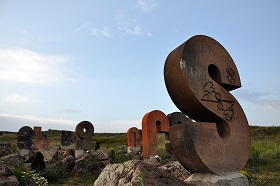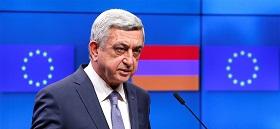Armenia has been in turmoil for the past few days. The fact that the central streets of Yerevan were packed with protesters did nothing to prevent ruling coalition MPs from convening in the National Assembly and voting for the appointment of Serzh Sargsyan as Prime Minister. However, the protests in the Armenian capital continue, and the situation is heating up.
To all appearances, the powers that be were “high” on their success. The reaction of Armenian society to the establishment of a new government with Karen Karapetyan at the helm had been generally positive, a fact that helped the Republican Party of Armenia (RPA) win the elections. Not only did the opposition suffer an undeniable defeat, it found itself split into rivalling groups. The election results were largely perceived as a manifestation of public trust in the RPA as a whole, and in Sargsyan personally. It would seem, however, that the authorities let their guard down and failed to take into account the fact that a portion of society had grown tired of the former president.
If the previous protests are anything to go by, the opposition’s chances of success are slim, although the likelihood of a positive outcome cannot be ruled out altogether. Even if the protests eventually run out of steam, as has repeatedly been the case in the past, the last several days have already caused significant damage to Sargsyan’s legitimacy as the new Prime Minister.
The events of the last few days in Yerevan seem to have come as a surprise not just to the authorities and analysts, but to many opposition supporters as well. Only a week ago, it seemed that nothing could threaten Armenia’s internal political stability, and that the upcoming transition to a parliamentary republic would run smoothly. Ever since the December 2015 referendum, the transition process had followed the scenario envisioned by the authorities. At first glance, the same could be said of the 2017 parliamentary election, in which the ruling Republican Party of Armenia won a landslide victory and the opposition Yelk Alliance (Way Out) received less than 8 per cent of the votes. To be fair, Sargsyan is hardly a popular, charismatic politician: during his time as President, a sizeable portion of the population grew disillusioned with the government, which periodically gave rise to protests. All these protests, however, came to nothing, so this time around the possibility of the weak and divided opposition converting the public dissatisfaction into political action appeared to be negligible.
Nevertheless, Armenia has been in turmoil for the past few days. Mass civil disturbances paralysed Yerevan on April 16. Thousands of people took to the streets, including a great number of young people and students. There were also clashes with police. However, the opposition’s declared objective of preventing the vote on Sargsyan’s candidacy in parliament was not achieved. The fact that the central streets of Yerevan were packed with protesters did nothing to prevent ruling coalition MPs from convening in the National Assembly and voting for the appointment of Serzh Sargsyan as Prime Minister. However, the protests in the Armenian capital continue, and the situation is heating up.
What caused this chain of events? And why did the plan to hold a smooth constitutional reform eventually fail? First, Armenia has a specific political culture: street protests are considered something quite acceptable, and major protest actions take place once every two or three years. Moreover, protests have become, to an extent, an element of the political system because they often influence the balance of political forces and the content of political agendas.
Second, it is always easy for the opposition to unite behind a negative agenda, bringing together people of different views who have a shared aversion – in this case, an aversion to what would effectively amount to Sargsyan’s third term in power. This is why the current protests emerged so swiftly and have been unexpectedly effective, despite the fact that not all the protesters sympathize with Nikol Pashinyan and his political group Civil Contract, who were the primary organizers of the protests.
Finally, the authorities contributed considerably to the current conflict. To all appearances, the powers that be were “high” on their success. It is true that the four-day war in April 2016 and the seizure of a police station by opposition radicals in July of the same year presented major challenges, but the political elites managed to tackle both situations efficiently enough. The reaction of Armenian society to the establishment of a new government with Karen Karapetyan at the helm had been generally positive, a fact that helped the Republican Party of Armenia win the elections. Not only did the opposition suffer an undeniable defeat, it found itself split into rivalling groups. This is probably why the authorities let their guard down, perceiving the result of the election as a manifestation of public trust in the RPA as a whole, and in Sargsyan personally
Perhaps this is the reason why the authorities chose a somewhat uncompromising transition to a parliamentary republic. Under their scenario, Sargsyan would become Prime Minister virtually immediately upon stepping down as President and would be afforded full authority of the new political system. This plan was deemed preferable to other, more complex scenarios under which the premiership would go to one of Sargsyan’s associates and the former president would retain informal levers of influence on the government or would make a comeback after a certain period of time. Such a scenario would most likely not have resulted in major public dissent, but the authorities seem to have let their guard down and failed to take into account the fact that a portion of society had grown tired of the former president. Furthermore, the opposition was now able to accuse Sargsyan of insincerity: back at the launch of the constitutional reforms, Sargsyan had announced that he was not planning to stand for the post of Prime Minister. The subsequent explanations of why he should stay in power after all were apparently too ham-fisted to convince the public, and only further antagonized the ex-president’s opponents.
One way or another, Sargsyan’s de facto third term in power did not get off to a good start. If the previous protests are anything to go by, the opposition’s chances of success are slim, although the likelihood of a positive outcome cannot be ruled out altogether. However, even if the protests eventually run out of steam, as has repeatedly been the case in the past, the last several days have already caused significant damage to Sargsyan’s legitimacy as the new Prime Minister. The problem of controversial election results and post-election protests has always been high on the agenda of post-Soviet Armenia, irrespective of the personal characteristics and political affiliations of the country’s official leaders. The first such protests, back in 1996, were against President Levon Ter-Petrosyan, who positioned himself as a liberal and a democrat. Sargsyan himself was the target of protests at the beginning of both his presidential terms; the first time, in March 2008, the situation escalated to shots being fired in the streets of Yerevan. This is why, after the 2017 elections, Sargsyan and his associates repeatedly pointed to the absence of protests as an indication that their plan to switch the country to a parliamentary republic was sound. If nothing else, the protests of the last few days, the biggest for a decade, discredit this thesis.






